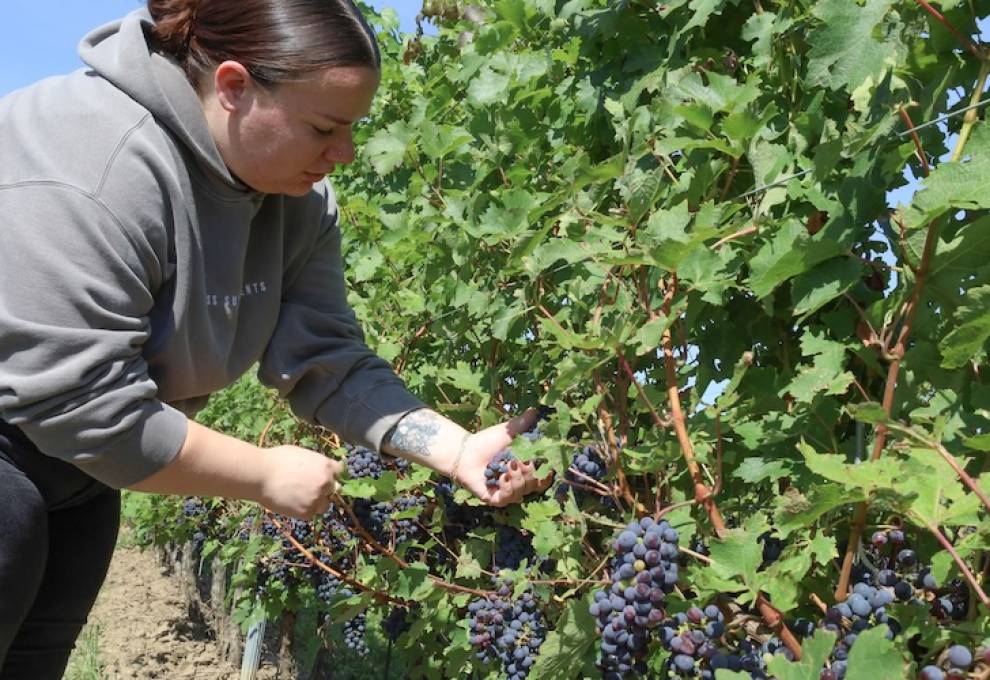
With harvest underway in Niagara, experts from Brock University’s Cool Climate Oenology and Viticulture Institute (CCOVI) say the region is headed for a good crop despite the summer’s extreme heat and lack of rain.
“It looks like it is going to be an example of quality over quantity,” says CCOVI researcher and associate professor Jim Willwerth.
A damp spring combined with current moderate daytime highs and cooler evenings are helping to mitigate worries caused by the hot and dry summer conditions, says Willwerth, whose expertise includes soil, water and plant interactions.
“I don’t think it will be a short crop year, just some reduced yields when comparing to other years, especially for those growers without irrigation,” he says, adding that a smaller yield due to smaller berries on the vine traditionally means more concentrated and desirable flavours in the grapes.
“We will see how the fall weather goes but right now the quality is looking excellent,” he says.
Last year, Ontario’s three major producing regions — Niagara, Prince Edward Country and the Lake Erie North Shore — produced 65,000 tonnes of grapes, according to the Grape Growers of Ontario (GGO).
GGO chair Matthias Oppenlaender shares Willwerth’s optimistic outlook on this year’s harvest while also acknowledging the likelihood of a lower yield.
“The heat and drought in the summer were a challenge,” he says. “But even with a lower crop, the quality is excellent. We hope the cool nights and sunny days continue to carry us through to the end of harvest.”
Temperatures reached extreme highs over the summer, with several extended heat waves consistently measuring more than 35°C.
Worries of a short crop were compounded by limited summer rainfall, with many areas of Niagara getting a third of their normal precipitation, Willwerth says.
“Most rain, if it did arrive, came in brief thunderstorms that did not allow the soils to absorb much water,” he says.
While wet weather in the spring helped grapevines avoid summer water stress, Willwerth says conditions in June and July impacted “fruit set” and helped create the lower yield estimate.
“Fruit set is the time when flowers develop into berries, and the excessive heat appeared to impact that process leading to fewer berries and smaller clusters,” he says.
Willwerth is hopeful October will see continued moderate temperatures and precipitation.
Too much heat now, he says, will have a poor impact on acidity and flavours in the grapes, and drier conditions can help reduce diseases that can be caused by moisture and humidity.
“We want to retain acidity to give the grapes that cool climate freshness that we are known for,” he says. “If temperatures get too high now, acids will start to break down faster.”
He says growers and winemakers are looking for a balance.
“Hopefully we will have a gradual ripening period where we have good flavour, good sugar levels and optimal acidity,” he says.
CCOVI senior oenology scientist Jennifer Kelly runs the institute’s Pre-Harvest Monitoring program that serves as a free resource for industry to monitor ripeness of five varieties across the region from multiple vineyard sites, soil types and crop levels. From her perspective, the outlook is positive for local grape growers.
“The weather we are having now is really helping with a favourably slow progression of ripening,” she says, adding that the ripening rate could mean harvest 2025 will be extended by a couple weeks into early November.
“We are finding that sugar accumulation and acid degradation is happening a bit slower than it did last year,” she says. “More time on the vine is always a good thing.”
Oppenlaender agrees and says he expects this year’s conditions will result in a vintage that local growers and connoisseurs will happily remember.
“It will make for outstanding 100 per cent Ontario-grown VQA wine,” he says. “I am looking forward to tasting them.”
Source: Brock University October 2, 2025 news release

